As covered partly iin a previous article, the usage of sustainable and eco-friendly materials in LED-lighting continues to be one of the major trends in this year. Many manufacturers have increasingly reacted to this trend, e.g. by presenting themselves at trade fairs as eco-friendly manufacturers.
This trend is matched by an increasing consciousness of consumers and commercial csutomers asking for sustainble materials withing lighting fixtures. When speaking about such materials, natruallz recycled materials like scrap cardboard, glass waste, and plastic bottles come to mind. A new trand is the usage of salvaged or reclaimed wood that can be used to create sustainable lighting fixtures. This can add to aa rustic and eco-friendly touch to indoor spaces. The recent rise and popularity of wooden lamps in “Scandinavian Style” is an example of this development.
Namely Chinese manufactures have recently started using more and more bamroo material for the composition of LED lighting fixtures. In fact bamboo is a fast-growing and renewable material that can be used convenientsly in sustainable lighting products. Bamboo also convices by being durable, lightweight, and having a natural aesthetic.
Rattan, more commonly know when it comes to furniture, is another material used with lighting fixtures and take from palm plants. This material convinces through its flexibility and stability at the same time.
Since longer time sisal grass has been used for the production of lampshades and other lighting components. The material is both, biodegradable and renewable.
In the same way plant-based polymers: derived from sources like corn and sugarcane are used to create eco-friendly lighting fixtures.


